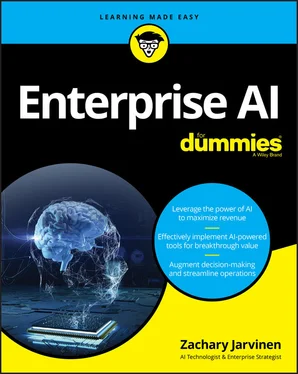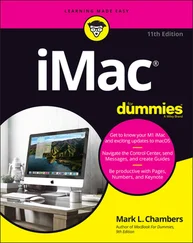4 Part 2: Exploring Vertical Market Applications
Chapter 5: Healthcare/HMOs: Streamlining Operations
Surfing the Data Tsunami
Breaking the Iron Triangle with Data
Matching Algorithms to Benefits
Examining the Use Cases
Chapter 6: Biotech/Pharma: Taming the Complexity
Navigating the Compliance Minefield
Weaponizing the Medical, Legal, and Regulatory Review
Enlisting Algorithms for the Cause
Examining the Use Cases
Chapter 7: Manufacturing: Maximizing Visibility
Peering through the Data Fog
Clearing the Fog
Clarifying the Connection to the Code
Examining the Use Cases
Chapter 8: Oil and Gas: Finding Opportunity in Chaos
Wrestling with Volatility
Pouring Data on Troubled Waters
Wrangling Algorithms for Fun and Profit
Examining the Use Cases
Chapter 9: Government and Nonprofits: Doing Well by Doing Good
Battling the Budget
Optimizing Past the Obstacles
Connecting the Tools to the Job
Examining the Use Cases
Chapter 10: Utilities: Renewing the Business
Coping with the Consumer Mindset
Utilizing Big Data
Connecting Algorithms to Goals
Examining the Use Cases
Chapter 11: Banking and Financial Services: Making It Personal
Finding the Bottom Line in the Data
Leveraging Big Data
Restructuring with Algorithms
Examining the Use Cases
Chapter 12: Retail: Reading the Customer’s Mind
Looking for a Crystal Ball
Reading the Customer’s Mail
Looking Behind the Curtain
Examining the Use Cases
Chapter 13: Transportation and Travel: Tuning Up Your Ride
Avoiding the Bumps in the Road
Planning the Route
Checking Your Tools
Examining the Use Cases
Chapter 14: Telecommunications: Connecting with Your Customers
Listening Past the Static
Finding the Signal in the Noise
Looking Inside the Box
Examining the Use Cases
Chapter 15: Legal Services: Cutting Through the Red Tape
Climbing the Paper Mountain
Planting Your Flag at the Summit
Linking Algorithms with Results
Examining the Use Cases
Chapter 16: Professional Services: Increasing Value to the Customer
Exploring the AI Pyramid
Climbing the AI Pyramid
Unearthing the Algorithmic Treasures
Examining the Use Cases
Chapter 17: Media and Entertainment: Beating the Gold Rush
Mining for Content
Striking It Rich
Assaying the Algorithms
Examining the Use Cases
5 Part 3: Exploring Horizontal Market Applications
Chapter 18: Voice of the Customer/Citizen: Finding Coherence in the Cacophony
Hearing the Message in the Media
Delivering What They Really Want
Answering the Right Questions
Examining Key Industries
Chapter 19: Asset Performance Optimization: Increasing Value by Extending Lifespans
Spying on Your Machines
Fixing It Before It Breaks
Learning from the Future
Examining the Use Cases
Chapter 20: Intelligent Recommendations: Getting Personal
Making Friends by the Millions
Reading Minds
Knowing Which Buttons to Push
Examining Key Industries
Chapter 21: Content Management: Finding What You Want, When You Want It
Introducing the Square Peg to the Round Hole
Finding Content at the Speed of AI
Expanding Your Toolbox
Examining the Use Cases
Chapter 22: AI-Enhanced Content Capture: Gathering All Your Eggs into the Same Basket
Counting All the Chickens, Hatched and Otherwise
Monetizing All the Piggies, Little and Otherwise
Getting All Your Ducks in a Row
Examining Key Industries
Chapter 23: Regulatory Compliance and Legal Risk Reduction: Hitting the Bullseye on a Moving Target
Dodging Bullets
Shooting Back
Building an Arsenal
Examining the Use Cases
Chapter 24: Knowledge Assistants and Chatbots: Monetizing the Needle in the Haystack
Missing the Trees for the Forest
Hearing the Tree Fall
Making Trees from Acorns
Examining the Use Cases
Chapter 25: AI-Enhanced Security: Staying Ahead by Watching Your Back
Closing the Barn Door
Locking the Barn Door
Knowing Which Key to Use
Examining the Use Cases
6 Part 4: The Part of Tens
Chapter 26: Ten Ways AI Will Influence the Next Decade
Proliferation of AI in the Enterprise
AI Will Reach Across Functions
AI R&D Will Span the Globe
The Data Privacy Iceberg Will Emerge
More Transparency in AI Applications
Augmented Analytics Will Make It Easier
Rise of Intelligent Text Mining
Chatbots for Everyone
Ethics Will Emerge for the AI Generation
Rise of Smart Cities through AI
Chapter 27: Ten Reasons Why AI Is Not a Panacea
AI Is Not Human
Pattern Recognition Is Not the Same As Understanding
AI Cannot Anticipate Black Swan Events
AI Might Be Democratized, but Data Is Not
AI Is Susceptible to Inherent Bias in the Data
AI Is Susceptible to Poor Problem Framing
AI Is Blind to Data Ambiguity
AI Will Not, or Cannot, Explain Its Own Results
AI Is Not Immune to the Law of Unintended Consequences
7 Index
8 About the Author
9 Advertisement Page
10 Connect with Dummies
11 End User License Agreement
1 Chapter 1 TABLE 1-1 Case Relationship for a Sentence TABLE 1-1 Case Relationship for a Sentence Case Threw Agent Boy Object Bone Recipient Dog The case relationship for other uses of “threw” won’t necessarily follow the same structure. The pitcher threw the game. The car threw a rod. The toddler threw a tantrum. Early iterations of rules engines and expert systems were code-driven, meaning much of the system was built on manually coded algorithms. Consequently, they were cumbersome to maintain and modify and thus lacked scalability. The availability of big data set the stage for the development of data-driven models. Symbolic AI evolved using the combination of machine-learning ontologies and statistical text mining to get the extra oomph that powers the current AI renaissance.
TABLE 1-2 Data Mining Versus Text Mining TABLE 1-2 Data Mining Versus Text Mining Data Mining Text Mining Overview Data mining searches for patterns and relationships in structured data. Text mining transforms unstructured textual data into structured information to enable data analysis. Data Type Structured data from large datasets is found in systems such as databases, spreadsheets, ERP, and accounting applications. Unstructured textual data is found in emails, documents, presentations, videos, file shares, social media, and the Internet. Data Retrieval Structured data is homogenous and organized, making it easy to retrieve. Unstructured textual data comes in many different formats and content types located in a more diverse range of applications and systems. Data Preparation Structured data is formal and formatted, facilitating the process of ingesting data into analytical models. Linguistic and statistical techniques — including NLP keywording and meta-tagging — must be applied to turn unstructured into usable structured data. Taxonomy There is no need to create an overriding taxonomy. A global taxonomy must be applied to organize the data into a common framework.
TABLE 1-3 Machine Learning as a Recipe TABLE 1-3 Machine Learning as a Recipe Machine Learning Recipe Task An algorithm is a step-by-step instruction set or formula for solving a problem or completing a task. Thaw the chicken. Season the chicken. Bake the chicken at 350°F. Objective Minimize errors (loss function) to attain the best approach to solve a task. Minimize the number of ingredients and steps required to prepare a tasty dish. Insight/result The algorithm learns from errors, finds the best approach, and generates insights and rules used to make predictions. Learn from your mistakes the next time you attempt the recipe. For example, if you process a brochure for the San Diego Zoo using the model, it would recognize the content about elephants and add the tag “elephant” to the document along with a score. The result is a prediction in the form of the percentage probability that the document contains information about elephants. Basically, the model makes a data-driven guess. In AI and data science, execution is not just implementing a plan. The methodology establishes an iterative process of learning, discovering, and then acting based on new information as opposed to a more traditional IT model of formulating a plan or idea and then rolling it out as planned.
TABLE 1-4 Artificial Intelligence, Machine Learning, and Deep Learning TABLE 1-4 Artificial Intelligence, Machine Learning, and Deep Learning Technique Description Example Artificial Intelligence Computing systems capable of performing tasks that humans are very good at Recognize objects, recognize and make sense of speech, self-driving cars Machine Learning Field of AI that learns from historical data toward an end goal or outcome Predict customers likely to churn Deep Learning Powerful set of machine-learning techniques that mimic the brain’s neuron activities Computer vision, colorize photos, deep fakes, mastering a game
Читать дальше












